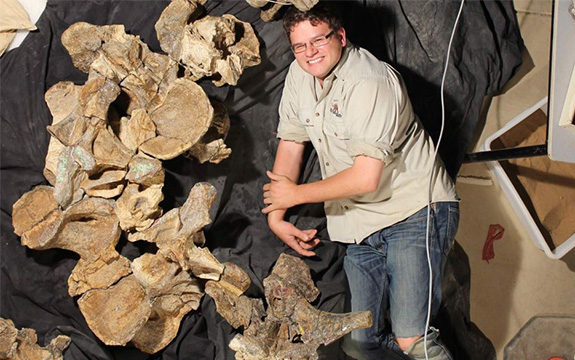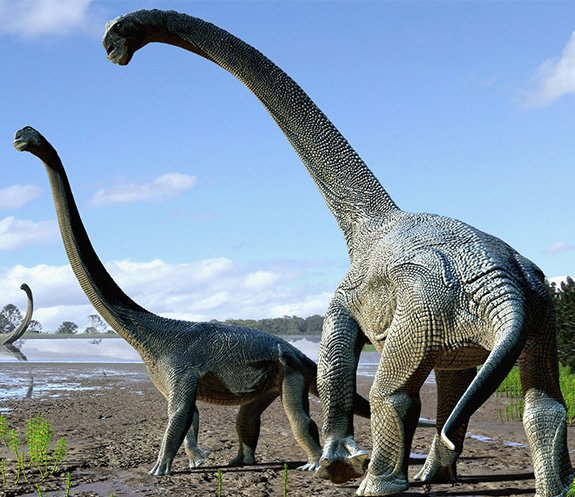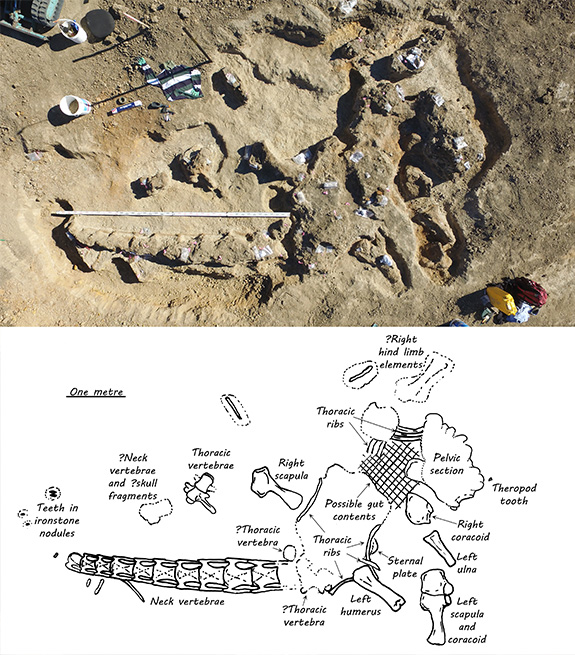Significant dinosaur find in outback Queensland

In Summary
- The remains of potentially the most complete sauropod dinosaur in Australia have been uncovered
- The discovery made on a property north-east of small Queensland town of Winton
- More than 25 per cent of the skeleton has been found
The remains of what might be the most complete sauropod dinosaur ever found in Australia have been uncovered by a team including a Swinburne palaeontologist.
The team has discovered four teeth, at least 10 interconnected neck vertebrae, and several vertebrae, shoulder and limb bones, all from one animal.
The dig was co-supervised by Dr Stephen Poropat, a postdoctoral fellow in palaeontology at Swinburne.
The discovery was made on a property north-east of the small Queensland town of Winton. In 2015, grazier Bob Elliott found fragments of dinosaur bone in one of his paddocks. It was not until the site was excavated, however, that the significance of the find was realised.
"This just might be the most complete sauropod ever found in Australia," says Dr Poropat.
“We probably have more than 25 per cent of the skeleton, which is phenomenal.”

Savannasaurus is part of the sauropod family | Image credit: Travis R. Tischler and Australian Age of Dinosaurs Museum of Natural History
Sauropod dinosaurs were the largest animals ever to have lived on land, with some exceeding 30 metres in length, and others achieving heights of 13 metres.
Two weeks of digging at the site revealed the bones of the sauropod dinosaur, now nicknamed ‘Judy’ after Mr Elliott’s mother, Judy Elliott. She and her husband David Elliott founded the Australian Age of Dinosaurs Museum in Winton in 2002, and she has coordinated the digs for more than a decade.
The fact that so many bones of “Judy” are preserved has led Dr Poropat to believe that this specimen will give scientists a better understanding of Australia’s Cretaceous sauropods.
“We will be able to understand many aspects of this sauropod's anatomy, simply because we have so much of its skeleton.
“By studying its teeth and neck in particular, we might be able to shed light on how it fed. Better yet, we might just have direct evidence of this too, since a section of the site between the chest and the hips preserves what might be gut contents.”

Uncovering the skeleton at the dig site in Queensland
If the team can prove that the stomach contents were preserved, they will be the first found in a sauropod dinosaur.
Dr Poropat says the findings may lead to even more questions.
“We still have a lot to learn about many aspects of sauropod behaviour, physiology, and – in the case of Australia's sauropods in particular – skeletal anatomy.
“This new specimen will probably prompt more questions than it answers, but it will still provide us with a unique snapshot of the life – and death – of at least one sauropod individual that roamed Australia 95 million years ago.”

A diagram explaining what has been unearthed
What do these findings tell us?
- The teeth and neck of this sauropod might shed light on how it fed.
- The possible gut contents found at the site might reveal exactly what this dinosaur ate.
- This dinosaur, which was about 12 metres long, was not fully mature when it died: neither of the shoulder girdles was fused, as is common in older animals.
The team will return to the site in August 2017 to continue the dig and uncover more bones.

